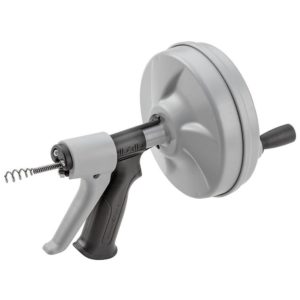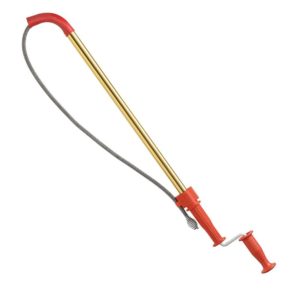
Clogged drains happen in every home. Fortunately, you have a couple of options for clearing them. Your first choice is to use a plunger, but if that doesn’t work you can use a drain snake to clear it yourself. However, if none of these options work, you should call a plumber as soon as possible.
What is a Drain Snake?
A drain snake or plumber’s snake is a slender and flexible metal cable with a small auger or uncoiled spring on one end and a handle on the other used to dislodge clogs. The drain snake is often used for difficult clogs that cannot be unclogged with a plunger. There are many different types of drain snakes. They come in a variety of shapes and sizes depending on the type and severity of the clogs. In addition, most plumbers use a drain snake to clear debris of any build up that happens in a sanitary sewer or clogged drain pipe.
What are the Different Types of Drain Snakes?
If you have a clogged tub, sink or, toilet, there are various types of drain snakes than you can use to help clear any debris and obstructions to restore normal water flow in the drain. Here are the 5 different types of drain snakes:
1. Drain Snake
A drain snake, also called a top snake or drum snake is the smallest of the drain-clearing snakes. Drain snakes are primarily used for clogs in tubs, showers, kitchen sinks, bathroom sinks, and washing machines. Most drain snakes have a 25 or 50 foot cable with a corkscrew tip for capturing any debris and obstructions. They also come in many different shapes and sizes and can be manual and electric.

2. Toilet Auger
A toilet auger, also called a closet auger is an inexpensive manual snake made for toilet stoppages. Toilet augers is used if you can’t clear a clog with a plunger of if there’s something stuck inside your toilet such as a sponge.

3. Mini-Rooter
A mini-rooter, also called a medium drain machine is a light-duty version of a sewer auger. Mini-rooters include a 3/8 inch diameter cable and have at least 50 to 75 feet of cable length. Mini-rooters also have an electric motor that spins the cable and different types of interchangeable cutter heads for various types of clogs. You can use mini-rooters to clear a kitchen or washing machine line from a roof vent and if you need to snake the drain from or under your kitchen sink or bathroom sink once you take off the trap.

4. Sewer Auger
A sewer auger is used for clearing 3 inch and 4 inch drains and sewer lines. Sewer augers have a heavy-duty electric motor that spins a large cage containing 100 foot or longer cables that are either 5/8 inch or 3/4 inch in diameter.

5. Flat Tape Auger
A flat tape auger is designed to work for water pipes that are 2 inches or less in diameter. Flat tape augers have a spear point tip which is used to push any debris and obstructions through the pipe rather than removing it.

Source: Drain Snakes for Plumbing
How Do You Use a Drain Snake?
If you’re unable to clear a clog with a plunger, your second option is to try using a drain snake. Below is a step-by-step on how to use a drain snake:
Step 1
Depending on the type and severity of the clog, your drain snaking procedure could get very messy. So, you should put on clothes you don’t mind getting dirty and lay some old towels beneath the pipes.
Step 2
This is an optional step. You can consider removing the p-trap. The p-trap is the curving piece of pipe beneath the sink which connects the sink to your drain pipe system. You can remove the p-trap with your hands or with an adjustable wrench. When you remove the p-trap, thoroughly inspect and clean it out. If you find any debris and obstructions, then you won’t have to drain snake.
Step 3
This is also an optional step. You can consider removing the trap arm. The trap arm is the part of the pipe between the p-trap and the wall pipe which holds the p-trap in place. Look for a metal or plastic nut connecting the trap arm. If you’re able to find one, loosen the metal or plastic nut to remove the trap arm. If you’re not able to find one, don’t try and remove the trap arm because it may be glued in place. When you remove the trap arm, you should inspect and clean it out like you did with the p-trap. Then, look inside the drain pipe for any debris and obstructions.
Step 4
If you didn’t follow step 2 and 3, you can begin to insert the head of the drain snake into the train or the access point on the wall. Make sure you run cold water while you snake if you didn’t remove the p-trap and trap arm. You should also keep in mind not to force the auger into the drain too hard because you can damage the drain pipe or entrance.
Step 5
You can begin uncoiling the drain snake using the handle. You should keep the handle of the snake as close to the entrance of the pipe as possible. Begin rotating the handle at a steady pace. If you feel pressure during this process, you’ve probably encountered the obstruction.
Step 6
Once you’ve encountered the obstruction, try to break it up as thoroughly as possible. Rotate the drain snake to loosen and dislodge the clog, but don’t jam the auger into the walls of the pipe. If you hear scraping noises, stop snaking and re-adjust.
Step 7
Remove the drain snake and run the tap water. Examine if the water drains or if it continues to collect. If the water drains, you’ve fixed the clog. You should also begin to re-assemble the sink components if you’ve removed the p-trap and trap arm. If the water continues to collect, you can try the procedure again to remove the clog.
Step 8
If you’re unable to clear the clog by yourself, then it’s time to call a plumber as soon as possible.
Source: How to Use a Plumber’s Snake the Right Way
Tips for Preventing Clogged Drains
You’ve probably experienced a clogged drain whether it be a sink, toilet, or shower. A clogged drain is bad news and there’s nothing more frustrating than it. In addition, a clogged drains always seems to happen at the worst possible time. It’s better to avoid clogged drains than to fix them so fortunately, there are many ways to keep clogged drains from happening. Here are 10 tips for preventing clogged drains:
1. Don’t Dump Grease
Grease is so bad for your drainage system. You should collect grease rather than dumping it. Pouring grease down your drain will eventually clog the pipes or slow the drain as it cools and solidifies in the pipes. Therefore, one of the best tips for preventing clogged drains is to avoid pouring grease down your drain. You can pour hot grease into a grease jar or can and once its full you can dump the solid grease into the trash.
Related Article: How Grease Can Damage Your Pipes
2. Install Drain Catchers
You should install drain catchers in order to help you to prevent hair, food, and other unwanted gunk from accidentally going down your drain.
3. Hot Water Flushing
You should pour hot water down the drain once a week. This will work wonders when it comes to breaking down and clearing away old gunk and grease buildup that went down your drain and formed deposits in the pipes. Pouring hot water will soften up the grease which helps it to flush down the pipe.
4. Collect Your Food Waste
It’s important to collect your food waste in a counter and add it to a compost pile. You can use a sink strainer to keep unwanted food scraps out of your kitchen drains.
5. Don’t Flush too Much at Once
You should keep in mind not to flush too much at once. You should also make sure not too flush too much toilet paper down the toilet at once too.
6. Only Flush Appropriate Things Down the Toilet
You should be careful about what you flush down the toilet. You should only be flushing appropriate things such as water, toilet paper, and human waste. Other objects such as diapers, tampons, and other hygiene products should never go down your toilet.
Related Article: 6 Step to Unclogging a Toilet
7. Avoid Chemical Drain Cleaners
You should avoid chemical drain cleaners when you have a bad clog in your drain. Did you know chemical drain cleaners can erode your drains and pipes over time?
8. Clean Sink Strainers
You should clean your sink strainers regularly whenever you wash the dishes. Residue can build up and easily slip through the sink strainer and end up in your pipes.
9. Clean Sink and Bathtub Stoppers
You should clean your sink and bathtub stoppers because grime and residue can slip through and end up down your drain. This will eventually clog your pipes and create all kinds of problems so the best way to avoid this is by removing these stoppers and cleaning them.
10. Keep Lint Out of the Laundry Tub Drain
You should keep link out of the laundry tub drain to avoid back up and overflow. You can avoid this by attaching a piece of pantyhose to the end of the hose that drains into your laundry tub to catch lint and other debris.
Source: Tips for Avoiding Clogged Drains
About Draintony
We are a locally owned and operated plumbing company, providing residential and commercial owner plumbing services. We specialize in Drain Repair, Drain Cleaning, Basement Waterproofing, Sump Pump Installation, Clogged Toilets and more. Our team at Draintony is dedicated to providing you premier plumbing quality and premier plumbing services.


